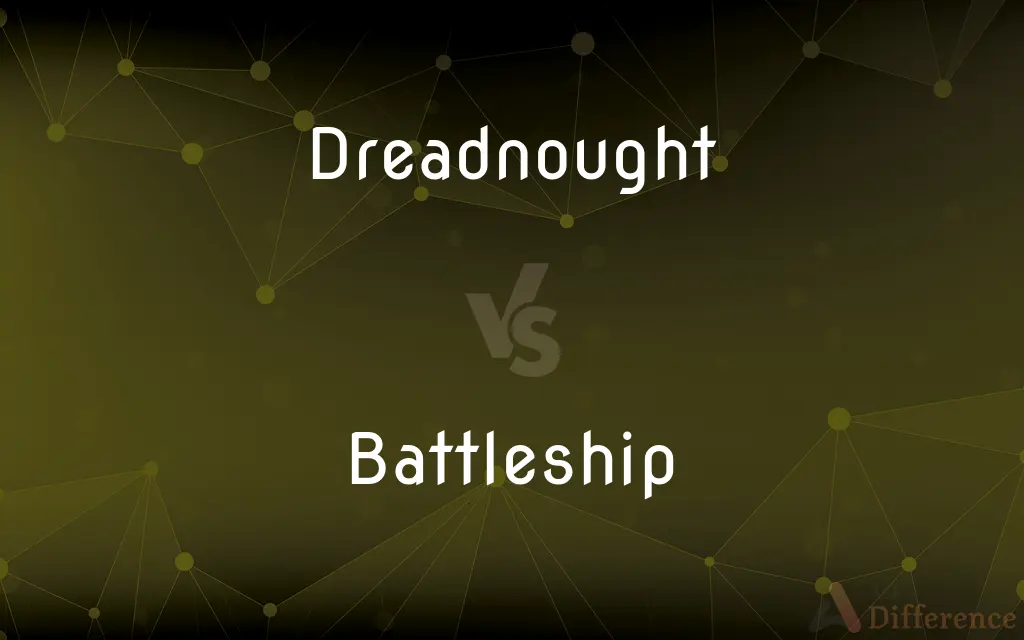Dreadnought vs. Battleship — What's the Difference?
By Fiza Rafique & Maham Liaqat — Updated on March 26, 2024
The Dreadnought revolutionized naval warfare with its all-big-gun armament and steam turbine propulsion, whereas battleships are a broader category, including those both before and after the Dreadnought era.

Difference Between Dreadnought and Battleship
Table of Contents
ADVERTISEMENT
Key Differences
The term "Dreadnought" refers specifically to the HMS Dreadnought, a British battleship launched in 1906, which marked a revolutionary design in naval warfare with its uniform, all-big-gun main battery and steam turbine engines, setting a new standard for battleships. Whereas "battleship" is a more general term for a class of large, heavily armored warships with powerful guns, designed for sea combat. The Dreadnought's introduction made all previous battleships obsolete, creating a distinction between "dreadnoughts" and "pre-dreadnoughts".
Dreadnought battleships emphasized speed, heavy armament, and longer range, focusing on large caliber guns as their primary weapon, minimizing the use of smaller guns. This approach maximized their effectiveness in naval engagements. On the other hand, pre-Dreadnought battleships, which were typical of the era before the HMS Dreadnought, carried a mix of gun sizes, with a few large guns for long-range engagements and numerous smaller ones for shorter ranges.
The design philosophy of the Dreadnought influenced not just the British Royal Navy but navies around the world, leading to an arms race particularly notable before World War I as countries sought to match or exceed the capabilities of the Dreadnought with their own battleships. Battleships that followed the Dreadnought's design principles are often referred to as "dreadnoughts", whereas earlier ships are known as "pre-dreadnoughts".
Dreadnoughts played a pivotal role in the naval strategy of the early 20th century, with their ability to engage enemies at great distances changing the nature of naval warfare. Battleships, including both pre-dreadnoughts and dreadnoughts, were seen as symbols of national power and prestige, playing key roles in both World Wars.
While the Dreadnought itself was eventually superseded by newer and more advanced battleships, its name remains synonymous with a major shift in naval architecture. In contrast, the term "battleship" encompasses a wide range of designs from the ironclad warships of the late 19th century to the massive, heavily armed ships that served until the end of World War II.
ADVERTISEMENT
Comparison Chart
Era
Early 20th century (specifically post-1906)
19th and 20th centuries
Design
All-big-gun main armament, steam turbine
Varied, including pre-dreadnought and later designs
Impact
Revolutionized naval warfare
Included a broad range of capital ships
Armament
Uniform large-caliber guns
Mix of large and smaller caliber guns (pre-dreadnought)
Symbolism
Marked the beginning of a new naval era
Represented naval power and national prestige
Compare with Definitions
Dreadnought
Led to an arms race among naval powers, each striving to build bigger and more powerful dreadnoughts.
The launch of the Dreadnought prompted other nations to accelerate their naval programs.
Battleship
Included a range of designs from the pre-dreadnought era to the modern battleships of World War II.
Battleship designs evolved significantly over their history.
Dreadnought
Became synonymous with cutting-edge naval technology and strategy.
Dreadnoughts were a key factor in naval planning during World War I.
Battleship
Were key players in major naval battles, demonstrating their firepower and tactical value.
Battleships engaged in some of the most significant naval battles of the 20th century.
Dreadnought
Marked a significant evolution in naval architecture, emphasizing speed and heavy armament.
The Dreadnought made all previous battleship designs obsolete.
Battleship
A large, heavily armored warship with a main battery consisting of the largest caliber guns.
Battleships were the backbone of the fleet in both world wars.
Dreadnought
Represents a specific era and approach to battleship design, focusing on uniform armament.
Naval historians often divide battleship development into pre-Dreadnought and dreadnought eras.
Battleship
Became obsolete with the advent of air power and missile technology.
After World War II, battleships were gradually phased out in favor of aircraft carriers.
Dreadnought
A type of battleship introduced in the early 20th century, characterized by an all-big-gun main armament and steam turbine propulsion.
The HMS Dreadnought set the standard for battleship design.
Battleship
Served as a symbol of national power and naval dominance.
The presence of battleships in a navy was a measure of national strength.
Dreadnought
The dreadnought (also spelled dreadnaught) was the predominant type of battleship in the early 20th century. The first of the kind, the Royal Navy's HMS Dreadnought, had such an impact when launched in 1906 that similar battleships built after her were referred to as "dreadnoughts", and earlier battleships became known as pre-dreadnoughts.
Battleship
A battleship is a large armored warship with a main battery consisting of large caliber guns, which dominated naval warfare in the late 19th and early 20th centuries. The term battleship came into use in the late 1880s to describe a type of ironclad warship, now referred to by historians as pre-dreadnought battleships.
Dreadnought
A battleship armed with six or more guns having calibers of 12 inches or more.
Battleship
A heavy warship of a type built chiefly in the late 19th and early 20th centuries, with extensive armour protection and large-calibre guns.
Dreadnought
A type of acoustic guitar with a larger body and louder sound than typical of most guitars.
Battleship
Any of a class of very large warships, heavily armored and armed with numerous large-caliber guns. Also called battlewagon.
Dreadnought
A battleship, especially of the World War I era, in which most of the firepower is concentrated in large guns that are of the same caliber.
Battleship
A large capital warship displacing thousands to tens of thousands of tons, heavily armoured and armed with large-caliber guns; now obsolescent and replaced by smaller vessels with guided missiles.
Dreadnought
(informal) A type of warship heavier in armour or armament than a typical battleship.
Battleship
A ship of the line.
Dreadnought
(music) A type of acoustic guitar with a very large body and a waist that is less pronounced than on other guitar shapes, producing a deep, bold sound.
Battleship
A non-functional rocket stage, used for configuration and integration tests.
Dreadnought
One that is the largest or the most powerful of its kind.
Battleship
A guessing game played on grid paper; see Battleship (game).
Dreadnought
A garment made of thick woollen cloth that can defend against storm and cold.
Battleship
An armor-plated warship built of steel and heavily armed, generally having over ten thousand tons displacement, and intended to be fit to combat the heaviest enemy ships in line of battle; the most heavily armed and armored class of warship at any given time.
Dreadnought
The cloth itself; fearnaught.
Battleship
Large and heavily armoured warship
Dreadnought
A person who fears nothing.
Dreadnought
Something that assures against fear.
Dreadnought
A British battleship, completed in 1906 - 1907, having an armament consisting of ten 12-inch guns mounted in turrets, and of twenty-four 12-pound quick-fire guns for protection against torpedo boats. This was the first battleship of the type characterized by a main armament of big guns all of the same caliber. She had a displacement of 17,900 tons at load draft, and a speed of 21 knots per hour.
Dreadnought
Any battleship having its main armament entirely of big guns all of one caliber. Since the Dreadnought was built, the caliber of the heaviest guns has increased from 12 in. to 13½ in., 14 in., and 15 in., and the displacement of the largest batteships from 18,000 tons to 30,000 tons and upwards. The term superdreadnought is popularly applied to battleships with such increased displacement and gun caliber.
Dreadnought
Battleship that has big guns all of the same caliber
Common Curiosities
Why was the Dreadnought significant?
The Dreadnought was significant for revolutionizing naval warfare with its design, leading to an international naval arms race.
What are pre-Dreadnought battleships?
Pre-Dreadnought battleships are those built before the introduction of the HMS Dreadnought, featuring a mix of gun sizes and slower speeds.
What defines a Dreadnought?
A Dreadnought is defined by its all-big-gun main armament and steam turbine propulsion, marking a significant evolution in battleship design.
Did the Dreadnought participate in World War I?
Yes, Dreadnoughts, including the HMS Dreadnought itself, played pivotal roles in naval strategy during World War I.
How does a battleship differ from a Dreadnought?
Battleships include a broad category of naval warships both before and after the Dreadnought era, varying in design and armament.
What replaced battleships as the dominant naval force?
Aircraft carriers and missile technology eventually replaced battleships as the dominant force in naval strategy.
Can a Dreadnought be considered a battleship?
Yes, a Dreadnought is a specific type of battleship that introduced new standards in naval armament and propulsion.
Were Dreadnoughts used in World War II?
While the original Dreadnought was not used in World War II, its design principles influenced battleships that served in the conflict.
How long was the Dreadnought era?
The Dreadnought era spans from the launch of HMS Dreadnought in 1906 until the end of World War I, though its influence continued longer.
How did battleship designs evolve after the Dreadnought?
After the Dreadnought, battleship designs continued to evolve, focusing on greater firepower, armor, and speed to surpass the Dreadnought's capabilities.
What was the last battleship in service?
The last battleships were decommissioned in the late 20th century, with the U.S. Iowa-class battleships being among the last to serve.
What made Dreadnoughts obsolete?
Advancements in naval aviation and missile technology made the Dreadnought and similar battleships obsolete.
How were battleships used in combat?
Battleships were used for fleet engagements, shore bombardment, and as symbols of naval power.
Share Your Discovery

Previous Comparison
Bowl vs. Saucer
Next Comparison
Rank vs. GradeAuthor Spotlight
Written by
Fiza RafiqueFiza Rafique is a skilled content writer at AskDifference.com, where she meticulously refines and enhances written pieces. Drawing from her vast editorial expertise, Fiza ensures clarity, accuracy, and precision in every article. Passionate about language, she continually seeks to elevate the quality of content for readers worldwide.
Co-written by
Maham Liaqat













































